Michael J. Behe's Blog, page 483
May 12, 2019
Colin Patterson: Can you tell me anything about evolution that is true?
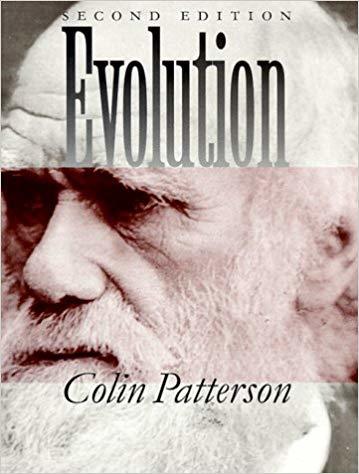 (1999)
(1999)Further to the story we noted last night, that possibly one-third of biologists now question Darwinism, this might be a good time to bring up Colin Patterson (1933-1998) again. He was a senior paleontologist at the British Museum of Natural History and he offered an awkward question to colleagues one day: “Can you tell me anything you know about evolution, any one thing, any one thing that is true?” He began to sense something amiss over forty years ago and this is the audio and transcript of a lecture he gave before the Systematics Discussion Group at the American Museum of Natural History, New York City in 1981: (two parts, transcript follows, courtesy Access Research Network):
The question is: Can you tell me anything you know about evolution, any one thing, any one thing that is true? I tried that question on the geology staff in the Field Museum of Natural History, and the only answer I got was silence. I tried it on the members of the Evolutionary Morphology Seminar at the University of Chicago, a very prestigious body of evolutionists, and all I got there was silence for a long time, and then eventually one person said, “Yes, I do know one thing. It ought not to be taught in high school.”
The show notes:
1981 lecture before the Systematics Discussion Group at the American Museum of Natural History, New York City.
“It’s true that for the last eighteen months or so, I’ve been kicking around non-evolutionary or even anti-evolutionary ideas. I think always before in my life, when I’ve got up to speak on a subject, I’ve been confident of one thing – that I know more about it than anybody in the room, because I’ve worked on it.
Well, this time that isn’t true. I’m speaking on two subjects, evolutionism and creationism, and I believe it’s true to say that I know nothing whatever about either of them. One or the reasons I started taking this anti-evolutionary view, or let’s call it non-evolutionary, was last year I had a sudden realization that for over twenty years I had thought that I was working on evolution in some way. Then one morning I woke up, and something had happened in the night, and it struck me that I had been working on this stuff for twenty years, and there was not one thing I knew about it. That’s quite a shock, to learn that one can be so misled for so long.
So either there was something wrong with me, or there was something wrong with evolutionary theory. Naturally, I know there is nothing wrong with me, so for the last few weeks, I’ve tried putting a simple question to various people and groups of people.
The question is: Can you tell me anything you know about evolution, any one thing, any one thing that is true? I tried that question on the geology staff in the Field Museum of Natural History, and the only answer I got was silence. I tried it on the members of the Evolutionary Morphology Seminar at the University of Chicago, a very prestigious body of evolutionists, and all I got there was silence for a long time, and then eventually one person said, “Yes, I do know one thing. It ought not to be taught in high school.” [laughter]”
Here are some snippets of Patterson’s issues with The Story of Evolution. Also, Patterson’s research works listed.
See also: Biology evolves: One third of biologists now question Darwinism Benjamin Dierker: This dissatisfaction is a matter of public record, even if it lacks public attention, and despite the narrative running contrary.
Follow UD News at Twitter!
Copyright © 2019 Uncommon Descent . This Feed is for personal non-commercial use only. If you are not reading this material in your news aggregator, the site you are looking at is guilty of copyright infringement UNLESS EXPLICIT PERMISSION OTHERWISE HAS BEEN GIVEN. Please contact legal@uncommondescent.com so we can take legal action immediately.
Plugin by Taragana
May 11, 2019
Biology evolves: One-third of biologists now question Darwinism
The figure is suggested by Michael Behe, based on reading and conversations with his colleagues. Of course, it’s a bit like asking how many citizens of the People’s Democratic Republic of Dungeon disapprove of the government. It’s not like you can ask them to vote on it or anything. Still:
A controversial letter to Nature in 2014 signaled the mounting concern, however slow and cautious, among thoughtful professional biologists. Other works by atheist authors like “What Darwin Got Wrong” and “Mind and Cosmos” find “fatal flaws” in the theory and assert it is “almost certainly false.”
Another project, The Third Way, seeks to avoid a false choice between divine intervention (which it outright rejects) and the Neo-Darwinian model (which it finds unsupported in the face of modern molecular theory) while presenting evidence to improve evolution theory beyond Neo-Darwinism. Some even believe billions of years have not been adequate for Darwinian theory to accomplish current complexity, as the theory currently exists.
This dissatisfaction is a matter of public record, even if it lacks public attention, and despite the narrative running contrary. Indeed dedicated Neo-Darwinists often say “no serious scientists disagree” or “only creationists have problems.” These contentions are increasingly disproven. Benjamin R. Dierker, “Why One-Third Of Biologists Now Question Darwinism” at The Federalist
Don’t miss Dierker’s interesting information about the Third Way.
Meanwhile, what was that story flapping past just the other day?
Oh, yes: Astronomer Martin Rees reacts to Suzan Mazur’s Darwin Overthrown. The story addresses the way Rees has been in the background of creative thinkers in biology who are grappling with what we now know.
Non-Darwinian things.
Naw. Just a fluke. Then there’s this one: Backing down on Darwinian fundamentalism? If we are going to talk about “considerable debate” and “much that is unknown,” let’s consider the way underlying Darwinian fundamentalism skews discussions.
Hey, look, everything could just be a fluke, you know.
See also: If no one is really a Darwinist any more… (as some commenters claim) … How come Darwinian philosopher Michael Ruse says, “Today’s professional evolutionists are committed Darwinians… ?” Could he be blowing smoke?
Follow UD News at Twitter!
Copyright © 2019 Uncommon Descent . This Feed is for personal non-commercial use only. If you are not reading this material in your news aggregator, the site you are looking at is guilty of copyright infringement UNLESS EXPLICIT PERMISSION OTHERWISE HAS BEEN GIVEN. Please contact legal@uncommondescent.com so we can take legal action immediately.
Plugin by Taragana
Educating oneself away from science denial: Two true stories
Recently, we learned in Leapsmag from a microbiology major at Oregon State University how she had to educate herself away from her parents’ anti-science attitudes:
As a young adult venturing into the field of science communication, I’ve become fascinated with understanding communities that foster antagonistic views toward science. When I first learned about fundamentalism, my parents’ behavior finally made sense. It is the foundation of the Religious Right, a right-wing Christian group which heavily influences the Republican party in the United States. The Religious Right crusades against secular education, stem cell research, abortion, evolution, and other controversial issues in science and medicine on the basis that they contradict Christian beliefs. They are quietly overturning the separation of church and state in order to enforce their religion as policy — at the expense of science and progress.
Growing up in this community, I learned that strong feelings about these issues arise from both a lack of science literacy and a distrust of experts. Sarah Olson, “My Parents Raised Me to Be a Science Denier, So I Educated Myself” at Leapsmag
Our Danish friend Karsten Pultz, author of Exit Evolution, read the dramatic story above of the flight from fundamentalism and responded by publishing his own account of how he escaped science denial. It is a somewhat different story, an excerpt from his book, translated into English:
—
When I was 7 or 8 years old, my father told me that in the old days, people believed that God had created life on earth. But since then we had become wiser, and science had now discovered that life came about by itself. It had been evolving for millions of years, and that man, in fact, descended from monkeys.
My father added that scientists only needed to find a certain fossil, the missing link between ape and man before they definitively had proven Darwin’s theory to be right. Who wouldn’t be impressed in such a situation, where Dad talks to you like you were an adult and shares with you groundbreaking scientific discoveries?
I certainly was impressed, and immediately convinced because just the similarities between humans and monkeys made clear to me that such an evolution must have taken place; it was pure logic. It very much made sense to me that science could uncover truths that mankind previously was unaware of, because, despite my young age I knew all about the technological progress that has taken place through historical time. I had trust in scientific progress, because as Richard Dawkins says; science works. So understandably I had no reason to doubt that God, creation and every single story in the Bible was nothing but myths that now had been debunked via scientific progress.
From the age of 7 until almost 40, I never encountered arguments against Darwin’s theory and I also never encountered one single person who didn’t believe in it.
Evolution became a regular subject of conversation for my father and me, and I especially remember another “fact” that he presented in my early childhood: In the near future, it will be possible to create artificial life in the laboratory. All over the world, scientists become more and more aware of how the cell works. It is just a matter of time before life can be produced artificially.
I had absolutely no reason to doubt that my father was telling the truth because I could experience the confirmation of all the information he provided me with on TV on a weekly basis. There were not only the many BBC broadcasts with David Attenborough but also nature programs produced by Danish national television which always contained the obligatory references to evolution. Later on, lessons in school followed up with even more confirmation of how splendid and true Darwin’s theory was.
So what went wrong?
Although I was only 7-8 years old, I could already see some problems with the theory. First and foremost, I could see a problem with the evolution of birds and flight. How on earth could wings evolve gradually over thousands or millions of years? Given that the evolution process works so slowly, it would mean that thousands of generations of individuals between dinosaurs and birds, wouldn’t have had fully developed wings and hence couldn’t actually fly. What benefit would a semi-developed wing be to the animal? Or a tenth of a fully developed wing? I spent many hours pondering this question and, fully convinced about evolution as I was, I regarded it as an interesting challenge to fantasize how wings and flight could have come about gradually.
From the age of 7 until almost 40, I never encountered arguments against Darwin’s theory and I also never encountered one single person who didn’t believe in it. The theory of evolution seemed to me a well established scientific theory, with a huge pile of evidence that simply grew bigger day after day as science progressed. It was a science on the same level as nuclear physics, exercised by well-educated men and women who had no bias whatsoever but instead objectively sought the truth about the origin of species.
Oh boy, was I wrong!
Evolution theory, in its most common form, has no room for a spiritual dimension, with some sort of god as an omnipresent principle. I would have had no trouble with the theory if it didn’t insist on reducing all human activity to merely the struggle for survival.
As a young teenager, I became interested in philosophy, literature, and art. I spent a lot of time on music and at the age of 13, decided that I wanted to study at the academy of music. Between the ages of 13 and 17, when I passed the entrance examination, I read many books by great thinkers like Dostojevsky, Voltaire, Nietzche, and Aldous Huxley. At the time, I had a problem with Darwin because the purely materialistic understanding that the theory of evolution imposes on life did not mesh well with the things I was interested in, and found joy and meaning in doing. I simply couldn’t understand how life could be reduced to a sheer fight for survival according to the principles of Darwin. Art, philosophy, the joy over beauty, goosebumps produced by a Brahms piano piece, creativity and loving thy neighbor, were things that suggested to me that there is more to life than the physical world, namely a spiritual dimension.
I was willing to accept the evolutionary explanation of kinship between species, for instance between humans and chimps, but had second thoughts about the materialistic and atheistic interpretation that still is prevalent, where life came about by random chemical processes and evolved into the great variety of life forms we see today, solely by means of unguided natural processes. Evolution theory, in its most common form, has no room for a spiritual dimension, with some sort of god as an omnipresent principle. I would have had no trouble with the theory if it didn’t insist on reducing all human activity to merely the struggle for survival.
Evolution was, as I understood it, a science that pointed towards a godless reality, and other parts of scientific endeavour did the same. (It is worth noting that Denmark is a highly secularized society which has the highest numbers of evolution believers in the world. According to two of the most prominent promoters of evolution, Richard Dawkins and Jerry Coyne the percentage of Darwin-believing Danes is a whopping 85).
But life goes on and I had other things to do than worry about the philosophical implications of evolution. Suddenly I had a wife and children, a house and a couple of old cars, so my skepticism about evolution faded. Only nature programs on TV with their obligatory nod to evolution, reminded me about the problem. Over the next few decades, it annoyed me when science programs tried to use evolution as a way of explaining why man composes symphonies, writes poems and literature, paints pictures, forms sculptures, cares about his neighbor, rejoices over good, and complains about evil…
The dramatic change in my views on evolution came about after my wife and I decided to home school our three children. It was a very unusual thing to do in Denmark. Only 50 children were homeschooled at that time in the entire country. We chose it in order to have more time with our children and play music together.
As I was searching for educational material, I ran into a branch of physics called quantum physics. Although it was not strictly relevant to my task, it caught my attention. I spent many hours watching lectures on the internet. What I really found exciting was the philosophical implications of quantum physics as described by contemporary physicists. For instance, we have the double slit experiment which shows that reality on the atom level is so weird that a purely materialistic interpretation of the universe is completely hopeless.
I discovered physicists who, through their research, became convinced that mind is more fundamental than matter. Physicists like John Hagelin and Amit Goswami talk about consciousness as primary and matter as secondary, as if matter, in fact, is a product of consciousness. And these two scientists are certainly not the first ones to have suggested that consciousness is more fundamental than matter. The father of quantum physics, Max Planck, who is celebrated as one of the greatest scientists of all time, whose equations are used in universities and in labs all over the world, was of the same opinion. In 1944 Planck said in a famous speech:
Gentlemen, as a physicist who all his life, within the most sober and rational science, has been devoted to the study of matter, I am certain to be free of the suspicion of being a dreamer, and so I say after my research on the atom; matter as such does not exist.
All matter originates and exists only by virtue of a force that brings the parts of the atom in vibration, and keeps the smallest solar system of the universe together. As there in the entire universe does not exist an intelligent force, nor an eternal force- man has not yet succeeded in inventing the perpetuum mobile- so must we assume behind this force the existence of a conscious intelligent spirit. This spirit is the basis of all matter. The visible but impermanent matter is not the reality and truth- because without spirit, matter wouldn’t exist at all- but the invisible, immortal spirit is the truth. Because every spirit belongs to a being, we are forced to assume it to be a spiritual being. Because spiritual beings do not come about by themselves, but must be created, I will not hesitate in fact, to call this secretive creator, like people of all cultures through millennia have done, God. Thereby moves the physicist who dealt with matter, from the realm of stuff to the realm of the spirit. And so is our task ended, and we must then pass on the research into the hands of the philosophers. – Quelle: Archiv zur Geschichte der Max-Planck-Gesellschaft, Abt. Va, Rep. 11 Planck, Nr. 1797.
It was quite a relief for me to discover that physicists, even some of the greatest, were not pure materialists and that they gave good reasons why they weren’t. I had been used to the idea or— let me just say it straightforwardly—indoctrinated to believe—that science supports a materialistic worldview. That science tells us “There is no God”. Now I was learning that even century-old experiments showed that materialism can’t be true. And a suspicion started to arise in my mind; why hadn’t I heard about these things? Why hadn’t I heard about statements like this one from giant of physicists Werner Heisenberg?: Der erste Trunk aus dem Becher der Naturwissenschaften macht atheistisch; aber auf dem Grund des Bechers wartet Gott. (“The first gulp from the glass of natural sciences will turn you into an atheist, but at the bottom of the glass God is waiting for you.”)
I only learned in school, that Heisenberg was a dangerous fellow who worked on giving the Nazis the A-bomb. That Heisenberg believed in God, not despite his scientific research, but because of it, was never mentioned. Heisenberg even wrote a book titled Physik und Philosophie which ought to be known to all Danish physics teachers. Heisenberg, after all, worked closely together with our own Niels Bohr and even spoke our language.
The more I delved into quantum physics, the more I started to realize that I had been the victim of materialist indoctrination through the educational system and through media. These two main conveyors of information were being run by biased people who made an effort to suppress any worldview other than scientific materialism. I’m grateful that the internet gave me the chance of acquiring knowledge without the materialistic/atheistic filter that information is put through by the academic elite.
My eight years of research on the topic of evolution has confirmed my suspicion, that there is a hidden atheistic agenda among many in the academic elite. It results in a “Berufsverbot” in the field of biology and probably also in other scientific branches, for people who want to question Darwin’s theory. It is sadly common that people who want to question evolution are having their careers ruined, and some even have to face personal harassment in addition to spoiled career opportunities. Discovery Institute, spearhead of the intelligent design movement, has a website where you can read about the consequences for Darwin doubters in academia.
What then was it that made me re-evaluate what I had learned about evolution? Well, in one of the books about quantum physics and the philosophical implications of discoveries made in this area, I stumbled on a sentence about evolution. Professor Amit Goswami writes in “God is not Dead” that there are gaps in the fossil record. What gaps could that be, I thought, I had never heard of any gaps—I had the clear impression that the fossils documented a gradual step by step evolution, that was what I had been told in school.
My curiosity was immediately ignited, and I remembered my anguish when trying to combine a worldview with room for soul and spirituality, with the purely materialistic worldview that is the result of belief in evolution. I thought that if a man who had been a professor of theoretical physics for 30 years could question evolution, then it was worth investigating because such a man could hardly be a complete ignorant fool.
From there everything went quickly. Any investigation is easily conducted today via the internet. I soon discovered a community of scientists and teachers who promote a scientific hypothesis called intelligent design, a competing theory to evolution that claims to have devastating evidence against Darwin’s theory. I also soon learned that these intelligent design people were extremely unpopular among those who adhered to evolution and that they consequently were accused of being creationists and religious fundamentalists with a secret evil agenda, to force a Christian theocracy upon the population. It was, and still is, mainly an American phenomenon and it was some time before I fully had comprehended what was going on. I didn’t know what creationism was; at that time I hadn’t yet met a creationist and couldn’t evaluate the accusations made by ID opponents.
I was thorough in my research. I read books both by proponents of evolution and by the ID scientists and spent several hundred hours watching lectures by educated men on both sides of the debate. I was in daily contact with evolutionists and doubters and engaged in many discussions on the internet. I was primarily debating Americans because the debate is most intense there.
I was surprised at the accusation that I was a creationist, because I took the side of intelligent design. I was raised an agnostic and had been a firm believer in evolution for 35 years, so I could not understand why my newly arisen doubt in evolution, necessarily made me a creationist. For me, the question about for and against evolution was primarily a scientific question. The religious consequences had to wait until the scientific questions were answered.
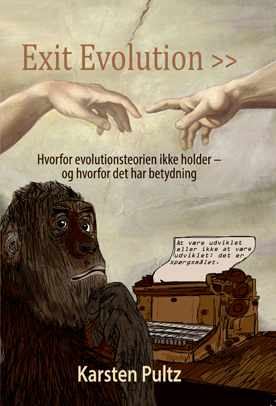
Slowly but surely I witnessed the unraveling of what I believed to be well-documented science that I had been totally indoctrinated into believing. During the first five years of my investigation, I went through different stages in my relationship with evolution.
The first stage, which I reached rather quickly, was the realization that evolution theory had many large, unsolved problems. But I still was of the opinion that it featured sufficient evidence to be taken seriously. At the next stage, I started to see intelligent design as a much stronger hypothesis but still assumed that there was evidence that spoke strongly in favor of evolution. In the third stage, I began to understand that evolution is a theory built on extremely weak evidence, and none of that evidence shows that only random processes were responsible for creating life. But I still had the impression that there was evidence that could only be explained within an evolutionary framework.
The fourth and last stage took me a long time to reach, maybe two years. At this point, I had come to fully reject evolution as a scientific theory. It took a long time because I still thought there might actually be some evidence up the sleeves of the evolutionists. Maybe I had missed some important arguments. The evolutionists I debated on the internet were very self-confident so it took a while before I felt safe to say that evolution is nothing but a myth based on no evidence at all. It is at best a philosophy and at worst a pseudoscience that only is kept alive because it functions as an extremely important supporting pillar for atheistic ideology. As Richard Dawkins has said, “Evolution makes it possible to become an intellectually fulfilled atheist.”
So this is the conclusion I arrived at after five years of investigation: Evolution never took place and that instead there is a huge amount of evidence for the hypothesis that life is intelligently designed.
—
See also: Denmark: Slowly developing a conversation about design in nature
Something Is Rotten In The State Of Denmark
Denmark: Perhaps Not So Rotten After All
and
Swedish Mathematician Explains Why He Sees Design In Nature (And Became A Christian)
Follow UD News at Twitter!
Copyright © 2019 Uncommon Descent . This Feed is for personal non-commercial use only. If you are not reading this material in your news aggregator, the site you are looking at is guilty of copyright infringement UNLESS EXPLICIT PERMISSION OTHERWISE HAS BEEN GIVEN. Please contact legal@uncommondescent.com so we can take legal action immediately.
Plugin by Taragana
Rob Sheldon: Researchers showed that the carbon state of the universe IS fine-tuned
As opposed to “robust.” He says, below, “We really need a word for this racket: Pay me or I’ll defend ID.” First, in a 2013 paper, we read,
Viability of Carbon-Based Life as a Function of the Light Quark Mass
Abstract: The Hoyle state plays a crucial role in the helium burning of stars that have reached the red giant stage. The close proximity of this state to the triple-alpha threshold is needed for the production of carbon, oxygen, and other elements necessary for life. We investigate whether this life-essential condition is robust or delicately fine-tuned by measuring its dependence on the fundamental constants of nature, specifically the light quark mass and the strength of the electromagnetic interaction. We show that there exist strong correlations between the alpha-particle binding energy and the various energies relevant to the triple-alpha process. We derive limits on the variation of these fundamental parameters from the requirement that
sufficient amounts of carbon and oxygen be generated in stars. We also discuss the implications of our results for an anthropic view of the Universe.
P1
Evgeny Epelbaum,1 Hermann Krebs,1 Timo A. Lähde,2 Dean Lee,3 and Ulf-G. Meißner2,4,5
1 Institut fu¨r Theoretische Physik II, Ruhr-Universita¨t Bochum, D-44870 Bochum, Germany
2 Institut fu¨r Kernphysik, Institute for Advanced Simulation, and Ju¨lich Center for Hadron Physics, Forschungszentrum Ju¨lich, D-52425 Ju¨lich, Germany
3 Department of Physics, North Carolina State University, Raleigh, North Carolina 27695, USA 4 Helmholtz-Institut fu¨r Strahlen- und Kernphysik and Bethe Center for Theoretical Physics, Universita¨t Bonn, D-53115 Bonn, Germany
5 JARA—High Performance Computing, Forschungszentrum Ju¨lich, D-52425 Ju¨lich, Germany
(Received 18 December 2012; published 13 March 2013)
DOI: 10.1103/PhysRevLett.110.112502 PACS numbers: 21.10.Dr, 21.30. x, 21.60.De
FREE DOWNLOAD: https://core.ac.uk/download/pdf/34997...
So Sheldon, our physics color commentator, deconstructs:
Years ago, and I’m going to guess about 1957 or so, Fred Hoyle used the “Anthropic Principle” to argue that Carbon-12 had a fine-tuned energy resonance in its nucleus.
Now there’s a couple of ways to measure a resonance–imagine a swing with your grandchild in it, and you are pumping it by holding up high on the chain, but with your eyes shut. If you don’t know when the swing is coming back, then pushing at the wrong moment will slow down the swing, or at least make it go sideways. So you could push faster and faster until you “felt” the chain pushing back on you. At that moment, you are transferring maximum force into the swing, and that means you found the resonance. You might also be able to tell by the squeals emanating from your grandchild.
We can do the same with a nucleus, using high energy electrons as our “push” and ramping up the energy of the electrons, and waiting to see when the nucleus gave off gamma rays. Now this measurement had already been done for C-12, but Hoyle didn’t find the resonance he was looking for. But he knew it had to be there because carbon was abundant enough in the universe for Hoyle himself to be alive, so there had to be a way to make it. The Big Bang didn’t make it, as Hoyle demonstrated in 1967 with the first Big Bang Nucleosynthesis code. Stars didn’t make much of it, because when the center of the star was hot enough to burn helium to carbon, it was well on its way to becoming a supernovae and turning everything into uranium. Nor was there a calmer, steadier way to make carbon by, say, adding a proton to Boron.
So Hoyle argued that there must be a secret path to Carbon, one that involved not the addition of protons but the triple collision of three helium atoms. But any collision that was strong enough to make the helium stick (overcome the Coulomb repulsion) had too much energy to keep them stuck together. What he needed was an energy resonance in the Carbon nucleus that converted He + He ->Be +He -> Carbon with no leftover energy that might tear the new nucleus apart. And he knew that this secret path had to be there or he wouldn’t exist. It took several years of pleading, but finally Willy Fowler did the measurement and found it just as Hoyle had predicted.
But this, says Marcus Chown in his book The Magic Furnace, was simply “the most outrageous prediction” ever made in science.”If [the 7.65 MeV state] did not exist, Hoyle reasoned, the universe would contain no carbon. And if there was no carbon, there would be no human beings. Thus Hoyle was saying – and nobody had ever used logic as outrageous as this before – that the mere fact he was alive and pondering the question of carbon was proof the 7.65 MeV state existed.”
With Fowler’s help, Hoyle did indeed find the 7.65 MeV state and the pair, working with astronomers Margaret and Geoffrey Burbidge, wrote “Synthesis of the Elements in Stars” (1957) for the Review of Modern Physics. Despite its four authors, the paper is principally Hoyle’s work. “To this day, he is the only person to have made a successful prediction from an anthropic argument in advance of an experiment,” adds Chown.
This success of fine-tuning as a concept rankled the materialists. So several papers have been written saying that the Hoyle state was not fine-tuned; Hoyle just got lucky. How do we tell the difference?
Epelbaum et al., 2013 think that the earlier refutations were poorly done. Having just invented a highly accurate numerical technique, they propose to test it on the fine-tuning of Hoyle’s state. So they take Hoyle’s prediction and ask “Just how fine-tuned is this resonance?” Or restating the question, “Was Hoyle lucky, or is the universe truly fine-tuned for carbon life?”
One way to test the validity of a theory or a model is to use data from a completely unrelated, independent source to see if the model is also optimum for the new stuff. In terms of neural-net AI you divide your data into two sets: a training set and a testing set. This is the equivalent testing set of independent measurements, to see how good the training really was.
If Hoyle is correct that the universe is fine-tuned for life, then the independent measures will likewise be fine-tuned. Contrariwise, if we are just lucky, then only the “Hoyle state” is fine-tuned, but everything else would be “broadly” tuned.
This paper grabs some other, unconstrained nuclear constants like the Coulomb repulsion strength and the “mass of the light quark” and tweaks them in a model to see whether it destroys the ability of the Hoyle state to make Carbon-12. If nothing much changes, then we were just lucky–if there’s a sharp peak, then it appears the universe is fine-tuned to make C-12.
When they are all done, they find that 3 independent variables in nuclear physics all have to be correlated within 2%. If we crank up the Coulomb force, then we have to crank up the light quark mass or we lose our C-12 production.
What does all this mean?
Well, it could mean that there are “hidden correlations” in nuclear physics that no one knew were there. Or it might mean that these three quantities have been assigned arbitrary values based on their outcome–which is to say–designed.
How is this different from the usual “fine tuning” arguments made by, for example, Luke Barnes? Luke argues that each fine-tuning variable is independent of the others, so for example, if variable-(a) gives 1:100 and variable-(b) gives 1:10, the combined statistic is 1:1000. This argument is rather that (a) and (b) are correlated, so their combined statistic is not 1000, but say, 200. This could mean either that we’ve found an explicit requirement of the designer (making C-12), or we’ve found a hidden theoretical connection between (a) & (b). What do they report?
“Beyond such relatively small changes [2%], the anthropic principle appears necessary at this time to explain the observed reaction rate of the triple-alpha process. In order to make more definitive statements about carbon and oxygen production for larger changes in the fundamental parameters, a more precise determination of A_s and A_t is needed from future lattice QCD simulations.”
So their conclusion is that previous debunking is wrong and the Hoyle state really is fine-tuned, but send more money and maybe they can undo the damage.
We really need a word for this racket– “Pay me or I’ll defend ID.” Dextortion?
![The Long Ascent: Genesis 1â 11 in Science & Myth, Volume 1 by [Sheldon, Robert]](https://i.gr-assets.com/images/S/compressed.photo.goodreads.com/hostedimages/1541285109i/26543752.jpg)
Rob Sheldon is the author of Genesis: The Long Ascent
See also: Rob Sheldon: The real reason there is a crisis in cosmology Nearly everything that has failed about the Big Bang model has been added because of bad metaphysics, a refusal to accept the consequences of a beginning. The remaining pieces of the Big Bang model that are failing and which can’t be attributed to bad metaphysics, were added from sheer laziness.
Doubt cast on new “exomoon”: Rob Sheldon explains Sheldon: There are red flags all over this data, but the investigators are standing by their measurement. This is what irreproducible papers look like in physics, and why the same crisis that afflicts other disciplines also afflicts physics.
and
Rob Sheldon: Here’s why physicists are surprised by the universe’s increased expansion rate The two methods differ in that one is “direct” and the other “indirect”. Clearly one or both of them is making a mistake. Since it is hard to find (and people have looked) a reason why the direct method is failing, the feeling is that the indirect method must have a mistake in its model.
Follow UD News at Twitter!
Copyright © 2019 Uncommon Descent . This Feed is for personal non-commercial use only. If you are not reading this material in your news aggregator, the site you are looking at is guilty of copyright infringement UNLESS EXPLICIT PERMISSION OTHERWISE HAS BEEN GIVEN. Please contact legal@uncommondescent.com so we can take legal action immediately.
Plugin by Taragana
Defending Civilization, 2: Linking gospel-warrant and the naturally evident law of our morally governed nature
On the table is a warrant regarding the core gospel message, e.g. vid:
. . . which is foundational to the civilisation which has come down to us. In effect, the Christian synthesis of the heritage of Jerusalem, Athens and Rome framed what became Christendom and has come down to us today, now usually styled Western Civilisation. The just linked also discusses through Schaeffer’s framework,
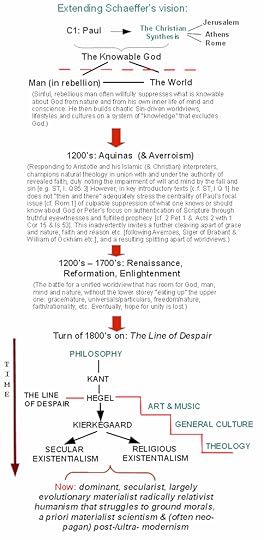 Extending (and correcting) Schaeffer’s vision of the course of western thought, worldviews and culture, C1 – 21
Extending (and correcting) Schaeffer’s vision of the course of western thought, worldviews and culture, C1 – 21. . . how for hundreds of years, there has been a growing push in thought, culture and general society to split apart “grace and nature” or reason and revelation,
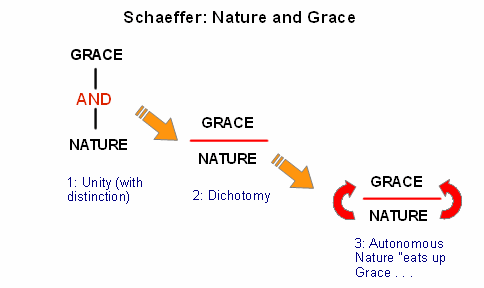 Dichotomising natrure and grace leads to disjointedness in western man’s worldview
Dichotomising natrure and grace leads to disjointedness in western man’s worldview. . . leading to a breakdown of the unifying core in both worldviews and cultural agendas. This reflects the classic problem of the one and the many.
In our time, there has been a longstanding push of dechristianisation and radical secularisation, culminating in a situation where, if one lists Christians by denom, “none” now comes out at the top of the list, alongside Catholicism and Evangelicalism. As a previous OP noted:
“‘Religious nones’ as they are called by researchers,
are a diverse group made up of atheists, agnostics, the spiritual, and
those who are no specific organized religion in particular. A rejection
of organized religion is the common thread they share,” CNN reports.“It is the first time we have seen this. The same questions have
been asked for 44 years,” political scientist and Baptist pastor Ryan
Burge told CNN. Timothy Meads, “ICYMI: ‘No Religion’ Now As Popular As
Catholicism, Evangelicalism” at Townhall
Of course, this is a grab-bag category and a bit of an anomaly as a
result. However, it does surface serious questions on how we form our
worldviews and how we respond to readily accessible — but increasingly
marginalised and often disdained — evidence
that the gospel core of the Christian faith (thus the integral gospel
ethics of turning from a sinful lifestyle through repentance) is
actually strongly warranted. In turn, this is driven by the
consideration that our thought-life is under moral government i/l/o
duties to truth, right reason (thus warrant), prudence, justice etc.
So, in part, the study tracks the degree to which many have been led
to doubt or dismiss that warrant, in the teeth of its actual strength.
Which, is not a healthy sign for the state of our civilisation (not to mention, our souls).
That’s why the already linked has in it a provocative remark, i/l/o
the significance of serious explanatory alternatives given the twelve
minimal facts about Jesus of Nazareth:
This, then, is the guilty secret at the heart of today’s
hyperskepticism toward, dismissal of, apostasy from and hostility
against the historic Christian faith: the evidence that warrants that faith is not only credible but strong. (I add: especially, once blatant question-begging through anti-supernaturalistic prejudice is off the table . . .
We need to soberly deal with this matter. Through, prophetically insightful intellectual and cultural leadership:
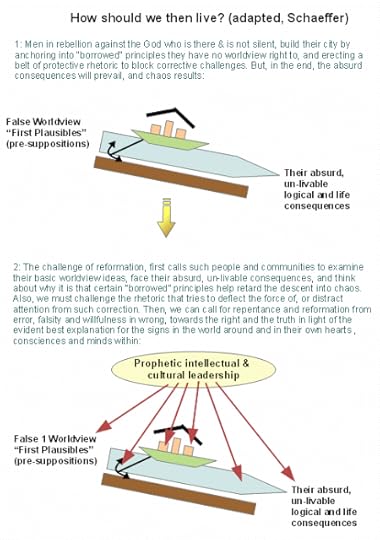
It is time for a fresh conversation, including on how the logic of
being points to a necessary being world root, and how our existence as
morally governed creatures leads to the need for a root of reality
capable of grounding ought. Where, there is precisely one serious
candidate . . . if you think not, kindly provide an alternative:
________ and warrant on comparative difficulties: ________. (Much harder
to do than to dismiss rhetorically or studiously ignore.)
Namely, the inherently good, utterly wise creator God, a necessary
and maximally great being. One, worthy of our loyalty and of the
responsible, reasonable service of doing the good that accords with our
manifest nature. This last, pointing to the significance of the natural
moral law that is attested by functional consciences.
In this context, we can see the significance of Cicero’s observation in de Legibus, c. 50 BC:
—Marcus [in de Legibus,
introductory remarks,. C1 BC]: . . . the subject of our present
discussion . . . comprehends the universal principles of equity and law.
In such a discussion therefore on the great moral law of nature, the
practice of the civil law can occupy but an insignificant and
subordinate station. For according to our idea, we shall have to explain
the true nature of moral justice, which is congenial and correspondent
[36]with the true nature of man. We shall have to examine those
principles of legislation by which all political states should be
governed. And last of all, shall we have to speak of those laws and
customs which are framed for the use and convenience of particular
peoples, which regulate the civic and municipal affairs of the citizens,
and which are known by the title of civil laws.Quintus [his real-life brother]. —You take a noble view of the
subject, my brother, and go to the fountain–head of moral truth, in
order to throw light on the whole science of jurisprudence: while those
who confine their legal studies to the civil law too often grow less
familiar with the arts of justice than with those of litigation.Marcus. —Your observation, my Quintus, is not quite correct. It
is not so much the science of law that produces litigation, as the
ignorance of it, (potius ignoratio juris litigiosa est quam scientia) . .
. . With respect to the true principle of justice, many learned men
have maintained that it springs from Law. I hardly know if their opinion
be not correct, at least, according to their own definition; for “Law
(say they) is the highest reason, implanted in nature, which prescribes
those things which ought to be done, and forbids the contrary.”
This, they think, is apparent from the converse of the proposition;
because this same reason, when it [37]is confirmed and established in
men’s minds, is the law of all their actions.They therefore conceive that the voice of conscience is a law,
that moral prudence is a law, whose operation is to urge us to good
actions, and restrain us from evil ones. They think, too, that
the Greek name for law (NOMOS), which is derived from NEMO, to
distribute, implies the very nature of the thing, that is, to give every
man his due. [–> this implies a definition of justice as the due balance of rights, freedoms and responsibilities] For
my part, I imagine that the moral essence of law is better expressed by
its Latin name, (lex), which conveys the idea of selection or
discrimination. According to the Greeks, therefore, the name of law
implies an equitable distribution of goods: according to the Romans, an
equitable discrimination between good and evil.The true definition of law should, however, include both these characteristics. And this being granted as an almost self–evident proposition, the origin of justice is to be sought in the divine law of eternal and immutable morality. This indeed is the true energy of nature, the very soul and essence of wisdom, the test of virtue and vice.
It is time for a fresh, sober-minded conversation.
So, we may now freely set out to frame how that natural moral law may be drawn out, by using a first principles approach, for instance:
1] The first self evident moral truth is that we are inescapably under the government of ought.
(This is manifest in even an objector’s implication in the questions, challenges and arguments that s/he would advance, that we are in the wrong and there is something to be avoided about that. That is, even the objector inadvertently implies that we OUGHT to do, think, aim for and say the right. Not even the hyperskeptical objector can escape this truth. Patent absurdity on attempted denial.)
2] Second self evident truth, we discern that some things are right and others are wrong by a compass-sense we term conscience which guides our thought. (Again, objectors depend on a sense of guilt/ urgency to be right not wrong on our part to give their points persuasive force. See what would be undermined should conscience be deadened or dismissed universally? Sawing off the branch on which we all must sit.)
3] Third, were this sense of conscience and linked sense that we can make responsibly free, rational decisions to be a delusion, we would at once descend into a status of grand delusion in which there is no good ground for confidence in our self-understanding. (That is, we look at an infinite regress of Plato’s cave worlds: once such a principle of grand global delusion is injected, there is no firewall so the perception of level one delusion is subject to the same issue, and this level two perception too, ad infinitum; landing in patent absurdity.)
4] Fourth, we are objectively under obligation of OUGHT. That is, despite any particular person’s (or group’s or august council’s or majority’s) wishes or claims to the contrary, such obligation credibly holds to moral certainty. That is, it would be irresponsible, foolish and unwise for us to act and try to live otherwise.
5] Fifth, this cumulative framework of moral government under OUGHT is the basis for the manifest core principles of the natural moral law under which we find ourselves obligated to the right the good, the true etc. Where also, patently, we struggle to live up to what we acknowledge or imply we ought to do.
6] Sixth, this means we live in a world in which being under core, generally understood principles of natural moral law is coherent and factually adequate, thus calling for a world-understanding in which OUGHT is properly grounded at root level. (Thus worldviews that can soundly meet this test are the only truly viable ones. If a worldview does not have in it a world-root level IS that can simultaneously ground OUGHT — so that IS and OUGHT are inextricably fused at that level, it fails decisively.*)
7] Seventh, in light of the above, even the weakest and most voiceless of us thus has a natural right to life, liberty, the pursuit of fulfillment of one’s sense of what s/he ought to be (“happiness”). This includes the young child, the unborn and more. (We see here the concept that rights are binding moral expectations of others to provide respect in regards to us because of our inherent status as human beings, members of the community of valuable neighbours. Where also who is my neighbour was forever answered by the parable of the Good Samaritan. Likewise, there can be no right to demand of or compel my neighbour that s/he upholds me and enables me in the wrong — including under false colour of law through lawfare; usurping the sword of justice to impose a ruthless policy agenda in fundamental breach of that civil peace which must ever pivot on manifest justice. To justly claim a right, one must first be in the right.)
8] Eighth, like unto the seventh, such may only be circumscribed or limited for good cause. Such as, reciprocal obligation to cherish and not harm neighbour of equal, equally valuable nature in community and in the wider world of the common brotherhood of humanity.
9] Ninth, this is the context in which it becomes self evidently wrong, wicked and evil to kidnap, sexually torture and murder a young child or the like as concrete cases in point that show that might and/or manipulation do not make ‘right,’ ‘truth,’ ‘worth,’ ‘justice,’ ‘fairness,’ ‘law’ etc. That is, anything that expresses or implies the nihilist’s credo is morally absurd.
(Thus, we see here our sense of justice for the weak, inarticulate and defenseless; starkly manifest in the difference between luring and catching a fish to become lunch and luring and despoiling then destroying a child. Such a child has not the wit nor words to plead his case, nor the strength to defeat his attacker nor yet the speed to outrun him. Where, that some take pity on the fish and will go out of their way to eat only vegetables is itself further eloquent testimony on the point. [Notice, there is no “people for the ethical treatment of fruit, root starches, grains and vegetables” movement.]
10] Tenth, this entails that in civil society with government, justice is a principal task of legitimate government. In short, nihilistic will to power untempered by the primacy of justice is its own refutation in any type of state. Where, justice is the due balance of rights, freedoms and responsibilities. (In Aristotle’s terms as cited by Hooker: “because we would take no harm, we must therefore do none; That since we would not be in any thing extremely dealt with, we must ourselves avoid all extremity in our dealings; That from all violence and wrong we are utterly to abstain, with such-like .”) Thus also,
11] Eleventh, that government is and ought to be subject to audit, reformation and if necessary replacement should it fail sufficiently badly and incorrigibly.
(NB: This is a requisite of accountability for justice, and the suggestion or implication of some views across time, that government can reasonably be unaccountable to the governed, is its own refutation, reflecting — again — nihilistic will to power; which is automatically absurd. This truth involves the issue that finite, fallible, morally struggling men acting as civil authorities in the face of changing times and situations as well as in the face of the tendency of power to corrupt, need to be open to remonstrance and reformation — or if they become resistant to reasonable appeal, there must be effective means of replacement. Hence, the principle that the general election is an insitutionalised regular solemn assembly of the people for audit and reform or if needs be replacement of government gone bad. But this is by no means an endorsement of the notion that a manipulated mob bent on a march of folly has a right to do as it pleases.)
12] Twelfth, the attempt to deny or dismiss such a general framework of moral governance invariably lands in shipwreck of incoherence and absurdity. As, has been seen in outline. But that does not mean that the attempt is not going to be made, so there is a mutual obligation of frank and fair correction and restraint of evil.
_______________* F/N: After centuries of debates and assessment of alternatives per comparative difficulties, there is in fact just one serious candidate to be such a grounding IS: the inherently good creator God, a necessary and maximally great being worthy of ultimate loyalty and the reasonable responsible service of doing the good in accord with our manifestly evident nature. (And instantly, such generic ethical theism answers also to the accusation oh this is “religion”; that term being used as a dirty word — no, this is philosophy. If you doubt this, simply put forth a different candidate that meets the required criteria and passes the comparative difficulties test: _________ . Likewise, an inherently good, maximally great being will not be arbitrary or deceitful etc, that is why such is fully worthy of ultimate loyalty and the reasonable, responsible service of doing the good in accord with our manifestly evident nature. As a serious candidate necessary being, such would be eternal and embedded in the frame for a world to exist at all. Thus such a candidate is either impossible as a square circle is impossible due to mutual ruin of core characteristics, or else it is actual. For simple instance no world is possible without two-ness in it, a necessary basis for distinct identity inter alia. (I add: as the God of ethical theism is a serious candidate necessary being, if he is possible he exists in at least one world and so also in all possible worlds as framework for a world to be. Those who infer or assert that God does not exist take up the burden to show that God is impossible of being; one that we may confidently hold, they cannot carry out successfully.)
So, we can see how a stable community can be built, framed on responsible, reasonable principles, many of them manifestations of the sort of natural law that Cicero and many others have discussed. In this framework, responsible government may then extend through civil law framed on justice and good community order. END
Copyright © 2019 Uncommon Descent . This Feed is for personal non-commercial use only. If you are not reading this material in your news aggregator, the site you are looking at is guilty of copyright infringement UNLESS EXPLICIT PERMISSION OTHERWISE HAS BEEN GIVEN. Please contact legal@uncommondescent.com so we can take legal action immediately.
Plugin by Taragana
May 10, 2019
Yale computer scientist gives up on Darwin
 David Gelernter, by Doc Searls (Flickr: 2010_08_05_techonomy_154) [CC BY 2.0], via Wikimedia Commons
David Gelernter, by Doc Searls (Flickr: 2010_08_05_techonomy_154) [CC BY 2.0], via Wikimedia Commons And finds that the world just makes more sense:
There’s no reason to doubt that Darwin successfully explained the small adjustments by which an organism adapts to local circumstances: changes to fur density or wing style or beak shape. Yet there are many reasons to doubt whether he can answer the hard questions and explain the big picture—not the fine-tuning of existing species but the emergence of new ones. The origin of species is exactly what Darwin cannot explain.
Stephen Meyer’s thoughtful and meticulous Darwin’s Doubt (2013) convinced me that Darwin has failed. He cannot answer the big question. Two other books are also essential: The Deniable Darwin and Other Essays (2009), by David Berlinski, and Debating Darwin’s Doubt (2015), an anthology edited by David Klinghoffer, which collects some of the arguments Meyer’s book stirred up. These three form a fateful battle group that most people would rather ignore. Bringing to bear the work of many dozen scientists over many decades, Meyer, who after a stint as a geophysicist in Dallas earned a Ph.D. in History and Philosophy of Science from Cambridge and now directs the Discovery Institute’s Center for Science and Culture, disassembles the theory of evolution piece by piece. Darwin’s Doubt is one of the most important books in a generation. Few open-minded people will finish it with their faith in Darwin intact.
Meyer doesn’t only demolish Darwin; he defends a replacement theory, intelligent design (I.D.). Although I can’t accept intelligent design as Meyer presents it, he does show that it is a plain case of the emperor’s new clothes: it says aloud what anyone who ponders biology must think, at some point, while sifting possible answers to hard questions. David Gelernter, “Giving Up Darwin” at Claremont Review of Books
That’s an important point to stress. Whether ID offers correct explanations is separate from the fact that Darwinism does not. Anyway, just think. Gelernter actually read the books, instead of merely opposing them. He goes on to develop his thinking in detail.
Gelernter is not alone in the wildernness:
A lot of writers, a lot of scientists, less gifted than Professor Gelernter refuse to think through these issues for themselves. We’re familiar with the results. Others take the plunge: Tom Wolfe, Thomas Nagel, Dennis Prager, and Ben Shapiro are four quite different but all fiercely independent voices who startled friends and enemies by studying the matter and coming out as Darwin critics. All had their brush with Stephen Meyer’s work, including Darwin’s Doubt and Signature in the Cell. David Klinghoffer, “Yale’s David Gelernter: Darwin’s Doubt Is “One of the Most Important Books in a Generation”” at Evolution News and Science Today:
See also: Remember David Gelernter On Darwin’s Thugs? He’s Hit The Big Time, Sort Of. “Fiercely Anti-Intellectual” At that point, the “punks, bullies, and hangers-on” were attacking philosopher Thomas Nagel
Follow UD News at Twitter!
Copyright © 2019 Uncommon Descent . This Feed is for personal non-commercial use only. If you are not reading this material in your news aggregator, the site you are looking at is guilty of copyright infringement UNLESS EXPLICIT PERMISSION OTHERWISE HAS BEEN GIVEN. Please contact legal@uncommondescent.com so we can take legal action immediately.
Plugin by Taragana
Bird “goes extinct” twice
 White-throated rail//© bennytrapp
White-throated rail//© bennytrapp That’s how it is being reported. What seems to have really happened is that the white-throated rail of Madagascar colonized distant islands and lost the ability to fly. It died out about 136 kya when its island was submerged. Then the same thing was happening to a successor colony again at 100 kya; it went flightless.
From ScienceDaily:
This means that one species from Madagascar gave rise to two different species of flightless rail on Aldabra in the space of a few thousand years…
“Conditions were such on Aldabra, the most important being the absence of terrestrial predators and competing mammals, that a rail was able to evolve flightlessness independently on each occasion.” Paper. (paywall) – Julian P Hume, David Martill. Repeated evolution of flightlessness in Dryolimnas rails (Aves: Rallidae) after extinction and recolonization on Aldabra. Zoological Journal of the Linnean Society, 2019; DOI: 10.1093/zoolinnean/zlz018 More.
It’s called “iterative evolution,” in the sense that the same evolution happened a second time, and maybe will happen a third time.
Note that loss of the ability to fly is treated in this story as a form of evolution, as if the loss resulted in greater complexity rather than less. As if it wasn’t fatal when the island was inundated. But it enables evolutionary biologists to say that “evolution happened.”
Although observed in as sea cows, ammonites, and sea turtles, interactive evolution was not observed before in birds:
According to a study published Wednesday in the Zoological Journal of the Linnean Society, the rail is an example of a rarely observed phenomenon called iterative evolution, in which the same ancestral lineage produces parallel offshoot species at different points in time. This means that near-identical species can pop up multiple times in different eras and locations, even if past iterations have gone extinct.Becky Ferreira, “This Bird Went Extinct and Then Evolved Into Existence Again” at Motherboard
It would be far more interesting, actually, if the birds had acquired a new skill instead of losing an old one. Maybe there will turn out to be a genetic pathway that facilitates devolution like this.
See also: The doomsday extinction rhetoric ignores the speciation mess Without a clearly understood concept of “species”, it’s hard to know what extinction even means. If all individual life forms are unique, then every death is an extinction. Where do we draw the line and why, exactly?
and
Devolution: Getting back to the simple life
Follow UD News at Twitter!
Copyright © 2019 Uncommon Descent . This Feed is for personal non-commercial use only. If you are not reading this material in your news aggregator, the site you are looking at is guilty of copyright infringement UNLESS EXPLICIT PERMISSION OTHERWISE HAS BEEN GIVEN. Please contact legal@uncommondescent.com so we can take legal action immediately.
Plugin by Taragana
Jonathan Bartlett: Swamidass gets the Evangelical Statement on AI wrong
 Jonathan Bartlett
Jonathan BartlettJonathan Bartlett says that, in his Wall Street Journal article, Joshua Swamidass — mainly known to our readers for his clashes with ID biologists — seems to misunderstand the Statement entirely on the question of moral responsibility:
Essentially, the statement merely restates traditional Christian theology regarding humans and machines. It continues to assert them in the case of a specific type of machine, artificial intelligence.
Swamidass’s criticism seems to miss this important distinction. The clearest example is his response to the question of moral responsibility. There, his criticism seems to misunderstand the Statement entirely…
Rather than lacking insight into AI issues, this band of theologians is especially sagacious in applying theology to them. Jonathan Bartlett, “A Critic of the Evangelical Statement on AI Misunderstands the Issues” at Mind Matters News
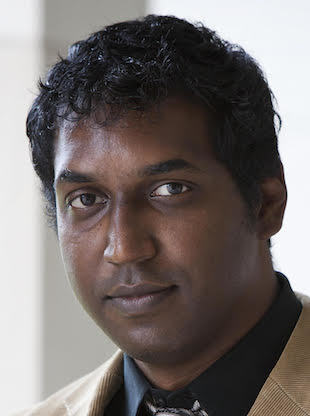 Joshua Swamidass
Joshua SwamidassBartlett doesn’t think Tesla needs any encouragement to avoid responsibility; quite the opposite.
See also: See also: New Evangelical Statement on AI is balanced and well-informed (Jay Richards)
Also by Jonathan Bartlett: Who assumes moral responsibility for self-driving cars?
and
Self-driving cars need virtual rails
Artificial Intelligence: An Evangelical Statement of Principles (April 11, 2019)
Follow UD News at Twitter!
Copyright © 2019 Uncommon Descent . This Feed is for personal non-commercial use only. If you are not reading this material in your news aggregator, the site you are looking at is guilty of copyright infringement UNLESS EXPLICIT PERMISSION OTHERWISE HAS BEEN GIVEN. Please contact legal@uncommondescent.com so we can take legal action immediately.
Plugin by Taragana
The doomsday extinction rhetoric ignores the speciation mess
 extinct European wild ox, believed to be the ancestor of modern cattle/Sturm
extinct European wild ox, believed to be the ancestor of modern cattle/SturmA veteran newser dissects recent UN apocalypse meltdown about wildlife extinction:
For starters, how many species are there? This is a fundamental question, but, surprisingly, all scientists can do is guesstimate. An influential 2011 paper in PLOS Biology estimated that there are 8.7 million species in the world, plus or minus 1.3 million. The IPBES seems to have adopted this figure. (There are no footnotes in its summary, making it difficult to check its claims, and the full report will be released later this year.) Previous estimates of the number of species ranged between 3 and 100 million. But of these 8.7 million, only about 1.3 million have been named and catalogued.
So the claim that a million species are at risk of being wiped out means that species are disappearing before we even know that they existed. This may be true, but it illustrates how mind-bending the extinction claim is. Taxonomy is a subtle science which depends upon algorithms nearly incomprehensible to the public. But that’s the job of journalists: to make the incomprehensible comprehensible. Before repeating the IPBS’s claim, they should have tried to understand the algorithm or at least ask questions about how the calculations were made. Michael Cook, “UN trumpets an extinction crisis” at MercatorNet
Without a clearly understood concept of speciation, it’s hard to know what extinction even means. If all individual life forms are unique, then every death is an extinction. Where do we draw the line and why, exactly?
Actually, the entire concept of speciation is an acknowledged mess, which is why no one wants to deal with it. In the absence of a clear way of determining how many “species” there are, games with numbers can focus attention on the freakout of the day, which means less attention for core questions of wildlife management and ecology.
See, for example: Polar bears overrun small northern Russian town The people who fear the bears will go extinct are not taking into account another possibility: They will become quite habituated to human food waste and thrive that way.
We face serious problems but doomsday rhetoric is often a cover for extraordinary politics more than anything else.
See also: A physicist looks at biology’s problem of “speciation” in humans
and
Insectologists swat insects are doomed papere
Follow UD News at Twitter!
Copyright © 2019 Uncommon Descent . This Feed is for personal non-commercial use only. If you are not reading this material in your news aggregator, the site you are looking at is guilty of copyright infringement UNLESS EXPLICIT PERMISSION OTHERWISE HAS BEEN GIVEN. Please contact legal@uncommondescent.com so we can take legal action immediately.
Plugin by Taragana
What is the warrant for the core gospel and linked ethics? (Does this matter?)
The gospel-based Christian synthesis of the heritage of Jerusalem, Athens and Rome — led by the Apostle Paul (Cf. Ac 17, Rom 1, Ac 27) — is a core but often unacknowledged or even resented part of the historical foundation of our civilisation. A civilisation which within living memory was described by Churchill as Christian civilisation. Not too much further back, it was usually referred to as Christendom.
But now, we see all around us the fruit of a centuries-long push to discredit and break that vital connexion; which has often been accompanied by a tendency to paint the legacy of Christendom in the most lurid colours, as though all that we have inherited is oppression, discrimination, injustice etc. That culminated in recent years in the sort of ill-founded, ill-advised fulminations that came from the pens of the so-called new atheists.
However, that effort has a cumulative impact of polarising, clouding, poisoning and polarising the atmosphere. So, let us first pause to rebalance by citing Bernard Lewis from his famous essay on the roots of Muslim rage:
The accusations are familiar. We of the West are accused of sexism, racism, and imperialism, institutionalized in patriarchy and slavery, tyranny and exploitation. To these charges, and to others as heinous, we have no option but to plead guilty — not as Americans, nor yet as Westerners, but simply as human beings, as members of the human race. In none of these sins are we the only sinners, and in some of them we are very far from being the worst. The treatment of women in the Western world, and more generally in Christendom, has always been unequal and often oppressive, but even at its worst it was rather better than the rule of polygamy and concubinage that has otherwise been the almost universal lot of womankind on this planet . . . .
In having practiced sexism, racism, and imperialism, the West was merely following the common practice of mankind through the millennia of recorded history. Where it is distinct from all other civilizations is in having recognized, named, and tried, not entirely without success, to remedy these historic diseases. And that is surely a matter for congratulation, not condemnation. We do not hold Western medical science in general, or Dr. Parkinson and Dr. Alzheimer in particular, responsible for the diseases they diagnosed and to which they gave their names.
Sobering.
Let us therefore move beyond Overton Window agit prop games and rebalance our thinking on the heritage and relevance of Christian civilisation:

To do so, we will need to cultivate the art of de-spinning and seeking sound warrant on key issues:
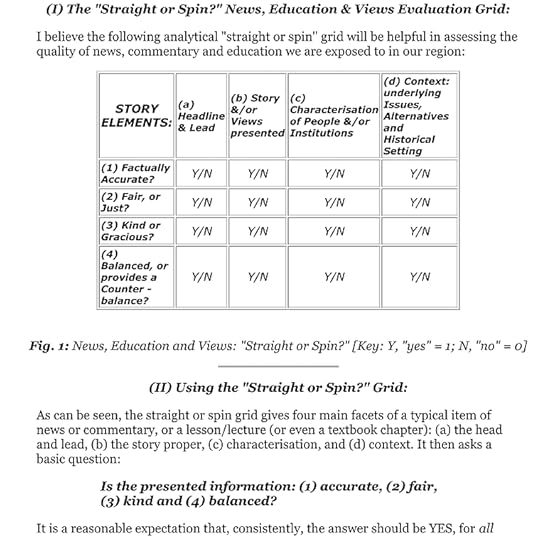
Similarly, I think we will find an adapted form of Francis Schaeffer’s outline of the history of dechchristianising trends over the centuries in reaction to the Pauline synthesis quite useful as background. For, what we face today, below his line of despair, comes from a long line of cultural and intellectual and spiritual breakdown:
 Extending (and correcting) Schaeffer’s vision of the course of western thought, worldviews and culture, C1 – 21
Extending (and correcting) Schaeffer’s vision of the course of western thought, worldviews and culture, C1 – 21A key element in that analysis is the disintegration of worldviews as autonomous nature “eats up” grace:
 Dichotomising nature and grace leads to disjointedness in western man’s worldview
Dichotomising nature and grace leads to disjointedness in western man’s worldviewAs a result, Christians in our day are called to prophetically insightful intellectual and cultural leadership, to call us back from a civilisational voyage of folly:

Let me add an illustration that helps us understand the faith-commitments that inevitably lie at the core of worldviews; which emerges as we reflect on the structure of warrant:
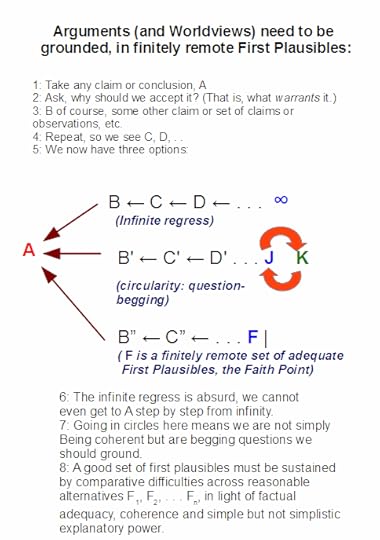 A summary of why we end up with foundations for our worldviews, whether or not we would phrase the matter that way}
A summary of why we end up with foundations for our worldviews, whether or not we would phrase the matter that way}One useful tool in the required prophetically insightful intellectual and cultural leadership is the seven mountains of influence model (which also traces to Schaeffer et al though it has been championed by Wallnau et al in recent years):
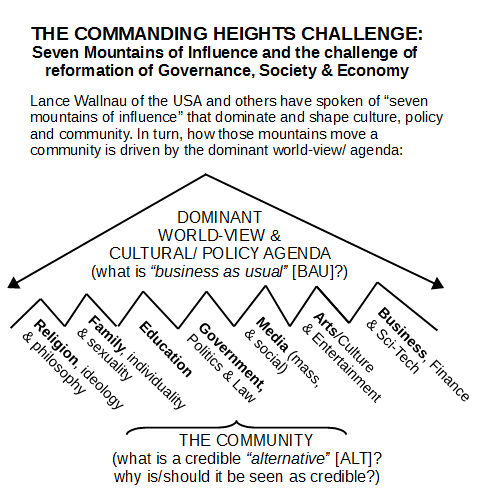
We may extend this model into the four R’s of godly reformation through discipleship:
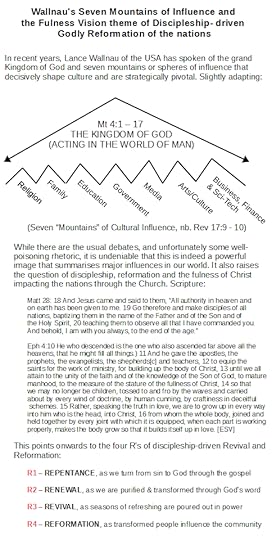
But, is such an approach well-founded? Yes, the gospel claims to be well warranted truth and necessarily incorporates moral transformation (as we face the discipleship-call to repentance, renewal and transformation from sinful lifestyles), but is that so?
Yes.
For one, we may use the so-called minimal facts approach to see just how well warranted the gospel is. Summarising from Apologetics Wiki:
The minimal facts method only uses sources which are multiply attested, and agreed to by a majority of scholars (ranging from atheist to conservative). This requires that they have one or more of the following criteria which are relevant to textual criticism:
Multiple sources – If two or more sources attest to the same fact, it is more likely authentic
Enemy attestation – If the writers enemies corroborate a given fact, it is more likely authentic
Principle of embarrassment – If the text embarrasses the writer, it is more likely authentic
Eyewitness testimony – First hand accounts are to be prefered
Early testimony – an early account is more likely accurate than a later oneHaving first established the well attested facts, the approach then argues that the best explanation of these agreed to facts is the resurrection of Jesus Christ . . . . [Source: “Minimal facts” From Apologetics Wiki. Full article: here. (Courtesy, Wayback Machine.)]
A list of these facts can be compiled, up to a dozen:
1. Jesus died by crucifixion [–> which implies his historicity!].
2. He was buried.
3. His death caused the disciples to despair and lose hope.
4. The tomb was empty (the most contested).
5. The disciples had experiences which they believed were literal appearances of the risen Jesus (the most important proof).
6. The disciples were transformed from doubters to bold proclaimers.
7. The resurrection was the central message.
8. They preached the message of Jesus’ resurrection in Jerusalem.
9. The Church was born and grew.
10. Orthodox Jews who believed in Christ made Sunday their primary day of worship.
11. James was converted to the faith when he saw the resurrected Jesus (James was a family skeptic).
12. Paul was converted to the faith (Paul was an outsider skeptic).
Why are such generally accepted? As I summarised:
That a Messiah candidate was captured, tried and
crucified — as Gamaliel hinted at — was effectively the death-knell for
most such movements in Israel in the era of Roman control; to have to
report such a fate was normally embarrassing and discrediting to the
extreme in a shame-honour culture. The Jews of C1 Judaea wanted a
victorious Greater David to defeat the Romans and usher in the day of
ultimate triumph for Israel, not a crucified suffering servant. In the
cases where a movement continued, the near relatives took up the mantle.
That is facts 1 – 3 right there. Facts 10 – 12 are notorious. While
some (it looks like about 25% of the survey of scholarship, from what I
have seen) reject no 4, in fact it is hard to see a message about a
resurrection in C1 that did not imply that the body was living again, as
Wright discusses here. Facts 5 – 9 are again, pretty clearly grounded.So, the challenge is to explain this cluster or important subsets of
it, without begging questions and without selective hyperskepticism.
It is not hard to see why the old objections commonly seen since C17 – 18 have fallen by the wayside; they just cannot cover the facts. Today, there are two men left standing: [A] the historic Christian view and [B] some sort of mass hallucination theory.
Of these, the latter is exceedingly problematic, as ” collective visions are not psychologically plausible as the cultural expectations of a resurrection would have been of a general one in the context of the obvious military triumph of Israel. Nor, does it explain the apparently missing body. Moreover, we know separately, that the culturally accepted alternative would have been individual prophetic visions of the exalted that on being shared would comfort the grieving that the departed rested with God.”
We are therefore left with the Morison challenge:
[N]ow the peculiar thing . . . is that not only did [belief in Jesus’ resurrection as in part testified to by the empty tomb] spread to every member of the Party of Jesus of whom we have any trace, but they brought it to Jerusalem and carried it with inconceivable audacity into the most keenly intellectual centre of Judaea . . . and in the face of every impediment which a brilliant and highly organised camarilla could devise. And they won. Within twenty years the claim of these Galilean peasants had disrupted the Jewish Church and impressed itself upon every town on the Eastern littoral of the Mediterranean from Caesarea to Troas. In less than fifty years it had began to threaten the peace of the Roman Empire . . . .
Why did it win? . . . .
We have to account not only for the enthusiasm of its friends, but for the paralysis of its enemies and for the ever growing stream of new converts . . . When we remember what certain highly placed personages would almost certainly have given to have strangled this movement at its birth but could not – how one desperate expedient after another was adopted to silence the apostles, until that veritable bow of Ulysses, the Great Persecution, was tried and broke in pieces in their hands [the chief persecutor became the leading C1 Missionary/Apostle!] – we begin to realise that behind all these subterfuges and makeshifts there must have been a silent, unanswerable fact. [Who Moved the Stone, (Faber, 1971; nb. orig. pub. 1930), pp. 114 – 115.]
This, then, is the guilty secret at the heart of today’s hyperskepticism toward, dismissal of, apostasy from and hostility against the historic Christian faith: the evidence that warrants that faith is not only credible but strong. (I add: especially, once blatant question-begging through anti-supernaturalistic prejudice is off the table. [Kindly cf. vid 1 below.])
Something, we need to face.
I think a video presentation may help some. First, background:
Next, the in a nutshell:
Those who want more may find Habermas himself helpful:
Others may find Craig helpful:
Or even the Strobel 101:
Now, all of this is in a specific context, where not only traditional marriage but also even one’s genetically stamped identity as male or female and linked cultural patterns have come under considerable pressure from the dechristianisers. Accordingly, it is relevant to pause to note on how a material part of these things is embedded in the moral transformation necessarily and inextricably involved in discipleship (and the underlying naturally evident moral law holds for all).
A good place to start is, the gospel: Jesus of Nazareth fulfilled 700 + year old specific scriptural prophecies of Messiah, including particularly resurrection from the dead. In that context, with 500 eyewitnesses, most still alive when such was committed to record 55 AD, a record handed down to us in unbroken, good chain of custody.
Speaking of . . .
 The chain of custody on the NT
The chain of custody on the NTLet us quote that record, which points to the official summary of the witness of the 500, clearly dating to 35 – 38 AD in Jerusalem, far too early and far too central to be the stuff of readily dismissible legend:
1 Cor 15:1 Now I would remind you, brothers,[a] of the gospel I preached to you, which you received, in which you stand, 2 and by which you are being saved, if you hold fast to the word I preached to you—unless you believed in vain.
3 For I delivered to you as of first importance what I also received:
that Christ died for our sins in accordance with the Scriptures,
4 that he was buried,
that he was raised on the third day in accordance with the Scriptures,
5 and that he appeared to Cephas, then to the twelve.
6 Then he appeared to more than five hundred brothers at one time, most of whom are still alive, though some have fallen asleep.
7 Then he appeared to James, then to all the apostles.
8 Last of all, as to one untimely born, he appeared also to me . . .
11 Whether then it was I or they, so we preach and so you believed.
This puts the issues just addressed through the minimal facts approach at the centre of our self-understanding as morally governed creatures and as a civilisation. For, once we see the warrant for the gospel by this and other means, it demands a duty- to- warranted truth- response: we must accept, then live by truth we know or should acknowledge, per good warrant. In which context, demanding that the church move away from its warranted core is ill-founded. And a civilisation that could readily access such warrant but elects to ignore instead is telling us a lot about itself. Nothing good.
It also establishes a clear centre of authority regarding truth and right conduct, the one who broke death.
clear And, on marriage, gender, sexuality etc, this is his record:
Matt 19:4 He [Jesus] answered, “Have you not read that he
who created them from the beginning made them male and female
[–> Gen 1 – 2, note the identified, naturally obvious case of
two distinct, reproductively complementary sexes, here anchored to
creation order for the human race], 5 and said, ‘Therefore a man shall
leave his father and his mother [–> implying the successive
generations of families built on man + woman + faithful commitment
–> well-nurtured children] and hold fast to his wife [–>
fidelity propagates from one generation to the next, how much more so
infidelity], and the two [= husband (male) + wife (female)] shall
become one flesh’ [–> through the act of marital, procreative
union, naturally leading to children]? 6 So they are no longer two but
one flesh. [–> ponder how the child reflects that union] What
therefore God has joined together [–> Adam and Eve and their
successors in one flesh union], let not man separate [–>
including, how much more, by violating the nature of marital union:
Adam + Steve, Eve + Mary, Either + fido, or a robot etc].”
Notice, he points to the naturally evident creation order and how this grounds a law of our manifest nature.
Such is antecedent to governments or cultural customs, it cannot be made by them or materially altered by them.
That is what many would defy today, to the obvious detriment of the community as the stabilising family is steadily eroded. Oh, it may still stand for many years yet but the implications point to a hard collision with reality.
The pivot of hope for a civilisation heading for the cliff:
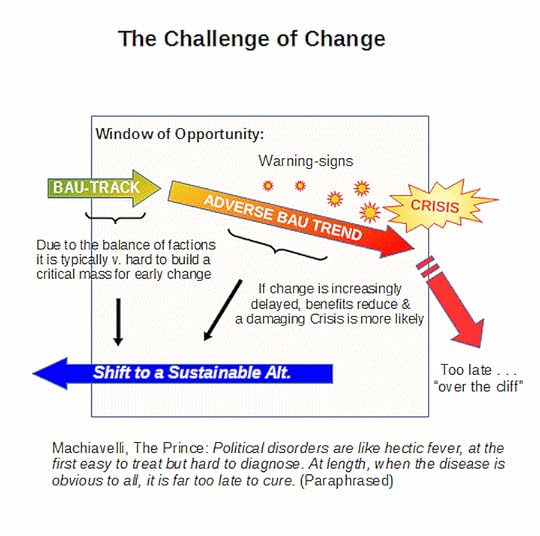
. . . is repentance towards the well-warranted truth and right attested by the gospel. So, will we turn back before it is too late? END
Copyright © 2019 Uncommon Descent . This Feed is for personal non-commercial use only. If you are not reading this material in your news aggregator, the site you are looking at is guilty of copyright infringement UNLESS EXPLICIT PERMISSION OTHERWISE HAS BEEN GIVEN. Please contact legal@uncommondescent.com so we can take legal action immediately.
Plugin by Taragana
Michael J. Behe's Blog
- Michael J. Behe's profile
- 219 followers




